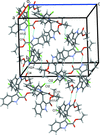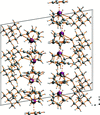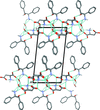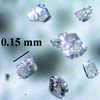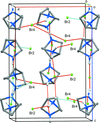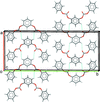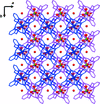issue contents
December 2017 issue

Cover illustration: A new hybrid material, (C15H14N3)[NiCl4]Cl, comprising an almost planar terpyridinium trication, a tetrahedral tetrachloronickelate dianion and a free chloride anion shows promising luminescent properties. In the crystal packing, successive layers of terpyridinium chloride showing C/N-H Cl interactions (layer A) and tetrachloronickelate (layer B) extend across the (100) plane. See: Zeghouan, Bendjeddou, Merazig & Daran [Acta Cryst. (2017). E73, 1937-1941].
Cl interactions (layer A) and tetrachloronickelate (layer B) extend across the (100) plane. See: Zeghouan, Bendjeddou, Merazig & Daran [Acta Cryst. (2017). E73, 1937-1941].
research communications
Download citation


Download citation


Resorcinarene-based tetraphosphonate cavitands are versatile molecular receptors which combine a π-basic aromatic cavity with hydrogen-bond acceptor groups at their upper rim. Their complexation properties span from neutral molecules to cationic species, and have been extensively studied both in solution and in the solid state. In this paper, we report the NMR solution studies and the crystal structure of a new supramolecular complex between a tetraphosphonate cavitand and the nitrosyl cation NO+. The cation is disordered over two equivalent positions, and interacts with two adjacent P=O groups at the upper rim of the cavitand through a dipole–charge interaction.
CCDC reference: 1583086
Download citation


Download citation


A barium-μ2-oxygen motif develops along the a axis, connecting symmetry-related dinuclear BaII–CoII cationic fragments in a wave-like chain, forming a one-dimensional metal coordination polymer. Non-coordinating ClO4− anions are located in the space between the chains in this first example of a macrocyclic ligand forming a BaII-based one-dimensional coordination polymer, containing CoII ions surrounded by a N4O2 donor set.
CCDC reference: 1582341
Download citation


Download citation


The asymmetric unit of the title compound consists of one and a half bischalcone molecules. In the crystal, molecules are linked into a three-dimensional network by C—H⋯F and C—H⋯O hydrogen bonds, some of the C—H⋯F links being unusually short (< 2.20 Å). Hirshfeld surface analyses are presented and discussed.
CCDC reference: 1449628
Download citation


Download citation


In the title compound, the two indole ring systems are approximately perpendicular to one another, making a dihedral angle of 80.9 (5)°. In the crystal, pairs of N—H⋯O hydrogen bonds link the molecules into inversion dimers and these are further linked by N—H⋯O and hydrogen bonds and short Cl—Cl contacts into supramolecular chains.
CCDC reference: 1582719
Download citation


Download citation


In the title compound, the toluenesulfonamide ring and the combined ring system involving the pyridone and benzothiazole rings subtend an interplanar angle of 39.86 (4)°. The pyridone and benzothiazyl rings are linked by an intramolecular N—Hamine⋯Nthiazole hydrogen bond. The molecules are linked by hydrogen bonds and an S⋯O contact to form layers parallel to the bc plane.
CCDC reference: 1582798
Download citation


Download citation


The molecular and crystal structure of a formal 20 electron zirconium(IV) complex bearing two cyclopentadienyl and one sterically demanding pentafulvene ligand is reported in which the pentafulvene is bound in an η5:η1 manner. The complex crystallizes together with toluene and n-hexane in a ratio of 1:0.125:0.125.
CCDC reference: 1582067
Download citation


Download citation


The title diastereomeric salt, formed between 2-amino-1,2-diphenylethanol (ADE) and aspartic acid (ASP), crystallizes as a monohydrate. In the crystal, the ASP anions are linked via N—H⋯O hydrogen bonds to form a 21 helix along the b-axis direction.
CCDC reference: 1582706
Download citation


Download citation


The simple synthesis and crystal structure of a new pyridinium bromide salt, 4-methyl-1-(3-phenoxy propyl)pyridinium bromide, are reported. The C–H⋯Br− interactions have an effect on the NMR signals of the ortho- and meta-pyridinium protons.
CCDC reference: 1581713
Download citation


Download citation


The molecules of the title compounds are effectively planar, apart from the methyl H atoms. In the crystals, C—H⋯O hydrogen bonds link the molecules into chains in one compound and into sheets in the other.
Download citation


Download citation


Crystal structures of hydrogen-bonded 1:2 dihydrate compounds of chloranilic acid with 2-carboxypyridine (I) and 2-carboxyquinoline (II) have been determined at 180 and 200 K, respectively. The base molecule in (I) is disordered over cationic and twitterionic states, while that in (II) is in a twitterionic form. In each crystal, the three components are linked by O—H⋯O and N—H⋯O hydrogen bonds, forming a layer structure.
Download citation


Download citation


The title compounds were synthesized from the commercially available dye quinizarin. In both compounds, the anthraquinone frameworks are close to planarity but there is a large difference in the conformation of the propyloxy group.
Download citation


Download citation


The crystal structures of two (oxothiazolidin-2-ylidene)acetamides, namely (Z)-2-[2-(morpholin-4-yl)-2-oxoethylidene]thiazolidin-4-one and (Z)-N-(4-methoxyphenyl)-2-(4-oxothiazolidin-2-ylidene)acetamide are described and compared with a related structure.
Download citation


Download citation


BaMn2(AsO4)2 was isolated from a high-temperature halide flux. Its crystal structure is characterized by infinite sheets made up of AsO4 units and distorted MnO6 octahedra while barium cations interleave successive sheets. The layered framework comprises weakly interacting [Mn4O18]28− tetrameric units. These units in the neighboring layer are separated from each other by 6.614 (2) Å (Mn⋯Mn distance).
CCDC reference: 1584656
Download citation


Download citation


The molecular structure of the 2,5-diazabicyclo[2.2.1]heptane parent ring has been characterized for the first time. The asymmetric unit contains two crystallographically independent cages of 2,5-diazabicyclo[2.2.1]heptane, each cage being protonated at the two nitrogen sites. The overall charge balance is maintained by four crystallogrphically independent bromide ions. In the crystal, the components of the structure are linked via a complex three-dimensional network of N—H⋯Br hydrogen bonds.
CCDC reference: 1578911
Download citation


Download citation


The title molecule is a tetrasubstituted truxinic-type cyclobutane derivative with a central ring that is almost planar despite of being placed in a general position. The molecular structure of the dimer shows that the four benzene rings of the substituents are oriented in such a way that potential steric hindrance is minimized, whilst allowing some degree of intermolecular π–π interactions for crystal stabilization.
CCDC reference: 1583527
Download citation


Download citation


The reaction of HgII with the bridging ligand bis(pyridin-3-ylmethyl)sulfane afforded a one-dimensional zigzag chain polymeric structure, with the charge balanced by two coordinated chloride anions. C—H⋯Cl hydrogen bonds and Hg—Cl⋯π interactions, together with C—H⋯π hydrogen bonds, stabilize the crystal structure.
CCDC reference: 1584773
Download citation


Download citation


The synthesis and crystal structure of tridentate pyridine-2,6-dicarboxylate CuII complex with a heterocyclic pyrazole ligand, a potential candidate for metal catalysts, are reported. The CuII atom is coordinated by three O atoms and two N atoms, provided by a tridentate pyridine-2,6-dicarboxylate, one pyrazole and one water ligand, forming a slightly distorted square-pyramidal geometry.
CCDC reference: 1584872
Download citation


Download citation


The title compounds are differing only by the position of the chlorine atom in the benzene ring. The molecular structures are very similar, except for the relative position of the hydroxyphenyl rings.
Download citation


Download citation


In the title compound, each CoII ion is coordinated by two pyridine N atoms from two individual dipyridyl ligands, two methanol O atoms and two chloride anions in an elongated octahedral geometry. Each dipyridyl ligand links two CoII ions, forming infinite zigzag chains.
CCDC reference: 1585746
Download citation


Download citation


An aqueous 1:1 co-crystal salt formed from imidazole and picric acid was obtained in methanol solution. A three-dimensional hydrogen-bonded network is formed in the crystal by N—H⋯O, O—H⋯O and C—H⋯O hydrogen bonds and is further consolidated by π–π stacking interactions between pairs of imidazolium cations and picrate anions.
CCDC reference: 1585713
Download citation


Download citation


Two molecules comprise the asymmetric unit in the title thioamide molecule, each of which exists as the thioamide–thione tautomer. In the crystal, the molecules assemble via an eight-membered thioamide {⋯SCNH}2 synthon to form dimeric aggregates.
CCDC reference: 1585129
Download citation


Download citation


This compound was previously shown to have anticancer activity in rodent test systems and recently found to have antifungal activity. The Pd centre is in a square-planar coordination environment with two chlorine atoms in cis positions and the remaining two coordination sites being coordinated by N and O atoms from deprotonated L-serine. Each of the Cs cations shows ninefold coordination with six chlorine and three O atoms resulting in a coordination environment that is similar to the well known Cs2SO4 structure.
CCDC reference: 1584689
Download citation


Download citation


The planar decachlorocyclopentasilane rings in the title compounds are coordinated by two chloride ions to generate inverse-sandwich complexes.
Download citation


Download citation


In the title structures, each molecules is connected to two other molecules via four N—H⋯O hydrogen bonds, resulting in a chain with a sequence of  (8) rings.
(8) rings.
Download citation


Download citation


The title crystals are isomorphous, with tetrameric Br⋯Br contacts as the principal packing interaction. No CN⋯Br or NC⋯Br contacts are observed.
Download citation


Download citation


The present work describes the synthesis and crystal structure of the new B-phenyloxazaborocine, C26H23BN2O2. The title compound adopts a zwitterionic form with a significant intramolecular N→B dative bond and intermolecular C—H⋯O interactions connecting molecules parallel to the b axis.
CCDC reference: 1586032
Download citation


Download citation


Reaction of EuI2(THF)2 with K[HB(3,5-iPr2pz)] (= KTpiPr2, pz = pyrazolyl) afforded the new europium(II) scorpionate complex (KTpiPr2)(3,5-iPr2pzH)2EuIII (1) in addition to the sterically crowded pyrazabole derivative trans-{(3,5-iPr2pz)HB(μ-3,5-iPr2pz)}2 (2) which were both structurally characterized through X-ray diffraction.
Download citation


Download citation


The title compound is a binuclear lanthanum(III) complex having each metal ion in decacoordination with oxygen atoms from 1,4-chdc2− ligands, acetate groups and coordinated water molecules to form a distorted bicapped square antiprismatic geometry. The strong intermolecular O–H⋯O and weak C–H⋯O interactions lead to the construction of a three-dimensional supramolecular architecture.
CCDC reference: 1546730
Download citation


Download citation


In the title compounds 1 and 2, the organic moieties adopt flattened conformations stabilized by an intramolecular N—H⋯N hydrogen bonds formed by the protonated amino group and the N atom of the pyridyl substituent. In 1, the organic moieties are linked with two N—H⋯Cl−-type hydrogen bonds, forming a C(4) graph-set. In its monohydrate, 2, the Cl− anion and a water molecule assemble the moieties into infinite bands showing hydrogen-bond patterns with graph sets C(6),  (12) and
(12) and  (8). Both crystals display π–π stacked supramolecular structures running along the b axis.
(8). Both crystals display π–π stacked supramolecular structures running along the b axis.
Download citation


Download citation


The synthesis, and structural determination of 2,2′:6′,2′′-terpyridine-1,1′,1′′-triium tetrachloridonickelate(II) chloride are reported. The crystal structure features N—H⋯Cl and C—H⋯Cl hydrogen bonds and Ni—Cl⋯π ring interactions.
CCDC reference: 1587116
Download citation


Download citation


The whole molecule of the title diarylcarbonate is generated by mirror symmetry, the mirror bisecting the central benzene ring, and the carbonate groups adopt an s-cis-s-cis conformation. In the crystal, there are only weak C—H⋯O hydrogen bonds and offset π–π interactions present.
CCDC reference: 1586885
Download citation


Download citation


The effect of the nature of substitutions on the structural parameters and hydrogen-bonding interactions in N-acylhydrazone derivatives has been studied by synthesizing and determining the crystal structures of three ortho-substituted N-acylhydrazone derivatives, namely (E)-N-{2-[2-(2-chlorobenzylidene)hydrazinyl]-2-oxoethyl}-4-methylbenzenesulfonamide (I), (E)-N-{2-[2-(2-methylbenzylidene)hydrazinyl]-2-oxoethyl}-4-methylbenzenesulfonamide (II) and (E)-N-{2-[2-(2-nitrobenzylidene)hydrazinyl]-2-oxoethyl}-4-methylbenzenesulfonamide (III).
Download citation


Download citation


Iridium(III) complexes based on 2,3′-bipyridine ligands are known to exhibit strong emission from blue to green that makes them of interest for organic light-emitting diodes and organic lighting uses. In the title compound, the IrIII ion adopts a distorted octahedral coordination environment defined by three C,N-chelating 2,6-difluoro-3-[5-(2-fluorophenyl)pyridin-2-yl]pyridin-4-yl ligands in a meridional manner. In the crystal, intermolecular C—H⋯F and C—H⋯π hydrogen bonds, as well as intermolecular C—F⋯π interactions, are present, leading to a two-dimensional network.
CCDC reference: 1586829
Download citation


Download citation


In the title compound, the two indole ring systems are approximately perpendicular to one another, making a dihedral angle of 89.7 (5)°. In the crystal, pairs of N—H⋯O hydrogen bonds link the molecules into the inversion dimers, which are further linked into supramolecular chains.
CCDC reference: 1587329
Download citation


Download citation


The title compound is a new heterotrinuclear CoII–CaII–CoII dimer of L1. L1 undergoes a cobalt-driven preorganization, leading to the formation of an electron-rich area able to host a hard metal ion such as CaII. In the dimer, two neutral [Co(H–2L1)] moieties, held together by the CaII ion, are rotated by 90°. The trinuclear complexes form layers perpendicular to the c axis; the perchlorate anions are located between the layers and interact with the complexes, as well as the lattice water molecules.
CCDC reference: 1586509
Download citation


Download citation


The asymmetric unit of the title complex contains one half of the complex molecule, one and a half ZnII cations, three benzoate (Bnz) and one pyridine-3-carbonitrile (CPy) molecule; the Bnz anions act as bidentate ligands through the carboxylate O atoms, while the Cpy anion acts as a monodentate N(pyridine)-bonding ligand. The complete centrosymmetric trinuclear complex thus comprises a linear array of three ZnII cations. In the crystal, the Bnz anions link to the Cpy N atoms via weak C—H⋯N hydrogen bonds, forming a two-dimensional network. The Hirshfeld surface analysis confirms the role of H-atom contacts in establishing the packing.
CCDC reference: 1587257
Download citation


Download citation


The title compound, methyl 2-[5-(2-hydroxyphenyl)-2H-tetrazol-2-yl]acetate, is the major product from the reaction between 2-(2H-tetrazol-5-yl)phenol and methyl 2-bromoacetate in the presence of potassium carbonate, which gave three isomeric products.
CCDC reference: 1587621
Download citation


Download citation


The crystal structure of the title compound has been determined at 100 K. In the crystal, O—H⋯O, C—H⋯On and C—H⋯F hydrogen bonds, and C—H⋯π and π–π interactions connect neighbouring molecules.
CCDC reference: 1587383
Download citation


Download citation


The 1,2-bis(pyridin-4-yl)ethene molecules bridge FeII cations to form polymeric chains running along the a axis.
CCDC reference: 1587771


 journal menu
journal menu














